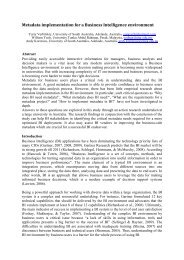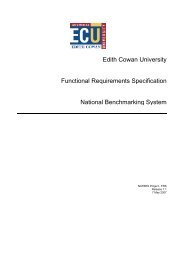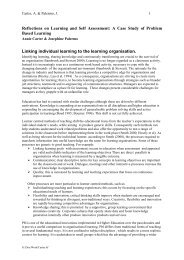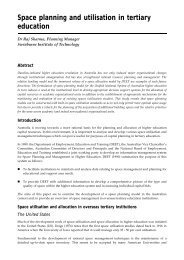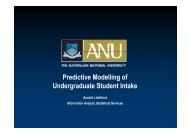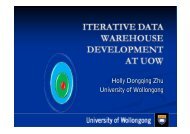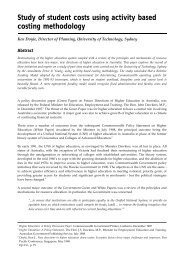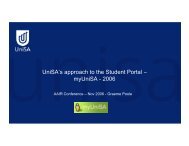Research in progress: Mapping the terrain of two applied ...
Research in progress: Mapping the terrain of two applied ...
Research in progress: Mapping the terrain of two applied ...
Create successful ePaper yourself
Turn your PDF publications into a flip-book with our unique Google optimized e-Paper software.
It appears that any move to enhance a research culture requires an understand<strong>in</strong>g <strong>of</strong> <strong>the</strong> multi‐dimensional<br />
academic role and <strong>the</strong> multiplicity <strong>of</strong> ways <strong>in</strong> which different academic staff need to be utilised and<br />
managed, elements <strong>of</strong> which are now discussed.<br />
Teach<strong>in</strong>g and research responsibilities and academic identity<br />
New Zealand has historically had a climate that is less supportive <strong>of</strong> research. The tension between <strong>the</strong> push<br />
for <strong>in</strong>creased full time equivalent students (FTEs) and research is an obvious one, when FTEs have tended to<br />
count for more than research achievements and research outputs (Elliott, 1996). Yet, more recent changes to<br />
<strong>the</strong> HE sector that seek to <strong>in</strong>crease <strong>the</strong> emphasis on research, <strong>in</strong>evitably pressures staff to re‐prioritise <strong>the</strong><br />
demands <strong>of</strong> teach<strong>in</strong>g, adm<strong>in</strong>istration and research.<br />
Whilst policy drives much <strong>of</strong> <strong>in</strong>stitutional strategy, staff <strong>in</strong>dicate that at a ‘more personal level’ <strong>the</strong>y are<br />
be<strong>in</strong>g <strong>in</strong>fluenced by <strong>the</strong> PBRF to re‐evaluate ‘<strong>the</strong>ir future goals, strategies and priorities’ (Middleton, 2005, p.<br />
147). <strong>Research</strong> studies undertaken at Victoria University (Well<strong>in</strong>gton) by Hall, Morris Mat<strong>the</strong>ws and<br />
Sawicka (2004) and Hall and Morris Mat<strong>the</strong>ws (2006) are <strong>in</strong>structive. In both studies, it was noted that <strong>the</strong><br />
teach<strong>in</strong>g commitments, service components and <strong>in</strong>creas<strong>in</strong>gly adm<strong>in</strong>istrative duties associated with<br />
academic labour have been shaped by <strong>the</strong> demands <strong>of</strong> <strong>the</strong> PBRF. This has also been reported <strong>in</strong> o<strong>the</strong>r New<br />
Zealand small scale studies conducted by Middleton (2005, 2006) at Waikato University and Ashcr<strong>of</strong>t (2006)<br />
at <strong>the</strong> University <strong>of</strong> Otago.<br />
Whilst <strong>the</strong>re is argument that <strong>the</strong>re is no s<strong>in</strong>gle academic identity shared by all academic staff (Churchman,<br />
2006) <strong>the</strong>re is also an acknowledgement that academic staff do struggle <strong>in</strong> <strong>the</strong>se times to ‘def<strong>in</strong>e <strong>the</strong>ir<br />
identity and those <strong>of</strong> <strong>the</strong>ir colleagues’ (ibid, p. 5). Recent studies undertaken <strong>in</strong> New Zealand on <strong>the</strong> impact<br />
<strong>of</strong> <strong>the</strong> PBRF on academic identities and academic staff morale parallel <strong>the</strong> ones undertaken <strong>in</strong> <strong>the</strong> UK about<br />
<strong>the</strong> <strong>Research</strong> Assessment Exercise (RAE). In <strong>the</strong> UK context which has had five rounds <strong>of</strong> <strong>the</strong> RAE <strong>the</strong>re has<br />
been considerable literature and critique (see Furlong and Oancea, 2006; Harris, 2005; Henkel, 2005; Lucas,<br />
2006; McNay, 2003; Pritchard, 2000; and Sikes, 2006). Many <strong>of</strong> <strong>the</strong>se studies and o<strong>the</strong>rs have <strong>in</strong>fluenced<br />
those undertaken <strong>in</strong> New Zealand about <strong>the</strong> effects <strong>of</strong> <strong>the</strong> PBRF <strong>in</strong>clud<strong>in</strong>g Ashcr<strong>of</strong>t & Nairn, 2004; Ashcr<strong>of</strong>t,<br />
2005, 2006; Codd, 2005, 2006a, 2006b; Hall, et al., 2004; Hall & Morris Mat<strong>the</strong>ws, 2006; Middleton, 2005, 2006;<br />
Roberts, 2006; and Smith & Jesson, 2005a, 2005b. All <strong>of</strong> <strong>the</strong>se authors argue that <strong>the</strong> PBRF regime is shap<strong>in</strong>g<br />
academic identity and that <strong>in</strong> <strong>the</strong>se environments <strong>the</strong> old adage ‘publish or perish’ has <strong>in</strong>tensified.<br />
The research project<br />
In light <strong>of</strong> <strong>the</strong> complexities surround<strong>in</strong>g what comprises a ‘research culture’ we <strong>in</strong>itiated a research project<br />
<strong>in</strong> 2007, with<strong>in</strong> <strong>two</strong> Auckland tertiary <strong>in</strong>stitutions, one a polytechnic (Institute <strong>of</strong> Technology) aim<strong>in</strong>g for<br />
university status, and <strong>the</strong> o<strong>the</strong>r, a more recently designated university. The selection <strong>of</strong> <strong>the</strong>se <strong>in</strong>stitutions is<br />
no co<strong>in</strong>cidence, as we work as academic staff members with<strong>in</strong> <strong>the</strong>m and <strong>the</strong>y provide examples <strong>of</strong> tertiary<br />
providers aspir<strong>in</strong>g to <strong>in</strong>creased status. The project’s primary aim is to exam<strong>in</strong>e staff perceptions <strong>of</strong> <strong>the</strong><br />
research fund<strong>in</strong>g regime <strong>of</strong> <strong>the</strong> PBRF and its impact on <strong>the</strong>ir pr<strong>of</strong>essional identity and research productivity.<br />
It is not <strong>the</strong> <strong>in</strong>tention to compare <strong>the</strong> f<strong>in</strong>d<strong>in</strong>gs with a more established university, but ra<strong>the</strong>r exam<strong>in</strong>e how<br />
<strong>the</strong>se <strong>in</strong>stitutions experience a work<strong>in</strong>g research culture. Three case studies were selected for <strong>the</strong> project’s<br />
sample, namely <strong>the</strong> Schools <strong>of</strong> Education, Design and Nurs<strong>in</strong>g; <strong>the</strong>se permit a comparison across differ<strong>in</strong>g<br />
discipl<strong>in</strong>es and between <strong>the</strong> <strong>two</strong> HEIs.<br />
The research design <strong>in</strong>cludes <strong>in</strong>itial <strong>in</strong>terview<strong>in</strong>g (Dick, 1990) with <strong>the</strong> <strong>two</strong> <strong>in</strong>stitutional heads <strong>of</strong> research,<br />
followed by a survey <strong>of</strong> all staff <strong>in</strong> <strong>the</strong> sample (about 240), us<strong>in</strong>g an onl<strong>in</strong>e questionnaire through<br />
SurveyMonkey. (A similar survey co<strong>in</strong>cidentally occurred at <strong>the</strong> University <strong>of</strong> Auckland, see Waayer &<br />
Hattie, 2007)) Semi‐structured <strong>in</strong>terviews with about 30 staff across both <strong>in</strong>stitutions provide fur<strong>the</strong>r<br />
<strong>in</strong>‐depth data for <strong>the</strong> f<strong>in</strong>d<strong>in</strong>gs. These f<strong>in</strong>d<strong>in</strong>gs are still be<strong>in</strong>g analysed, but at this stage, early assessment<br />
<strong>in</strong>dicates some <strong>in</strong>terest<strong>in</strong>g observations. Prelim<strong>in</strong>ary analysis suggests that for some staff <strong>in</strong> both <strong>in</strong>stitutions<br />
and across all three discipl<strong>in</strong>es (Design, Education and Nurs<strong>in</strong>g) <strong>the</strong> imposition <strong>of</strong> <strong>the</strong> PBRF and <strong>in</strong>ternal<br />
drivers to undertake research and to publish are result<strong>in</strong>g <strong>in</strong> a significant shift <strong>in</strong> academic roles and<br />
responsibilities.



